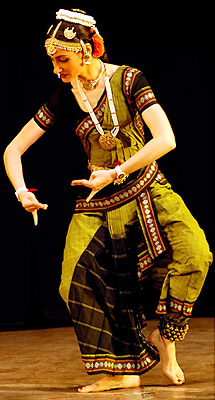 Technique of Bharatnatyam includes Abhinaya, Nritta and Nritya. The human body in Indian dance has been conceived as a mass which can be equally divided along a central median. When the weight is equally divided the completely balanced position that emerges is known as samabhanga. The slightly imbalanced position is called abhanga. The distinctive feature of Bharatnatyam is that it conceives movement in space along straight lines or in triangles.
Technique of Bharatnatyam includes Abhinaya, Nritta and Nritya. The human body in Indian dance has been conceived as a mass which can be equally divided along a central median. When the weight is equally divided the completely balanced position that emerges is known as samabhanga. The slightly imbalanced position is called abhanga. The distinctive feature of Bharatnatyam is that it conceives movement in space along straight lines or in triangles.The dancer begins with samapada position which is the basic position with the feet facing front. The dancer's body is neither relaxed nor rigid. Thereafter the foot is turned sideways which is known as the kalai tiruppudal in Tamil. Then is the ardhamandali position in which the feet are sideways and the knees are also bending sideways. The line joining the two shoulders is considered as base of one triangle and the waist as the imaginary apex of an inverted triangle. A second triangle is conceived with the thighs as the two sides and the line joining the two knees as the base of this triangle. The space covered by the two calves and the line joining the two knees forms the third triangle.
The head forms the first unit and its lateral movements are common. The torso is seen as a whole unit. The lower limbs are seen either as straight lines or two sides of an imaginary triangle in space. The upper limbs follow the lower limbs or weave a circular pattern which is covered by the lower limbs. It is the latter aspect with the use of torso as a single unit which gives Bharatnatyam its uniqueness.
As far as foot is concerned in the first position, the entire foot touches the bound and weight is equally distributed. This is known as tattu. In the same position the second type of foot contact occurs and third type of foot contact result when the heel touches the ground and the toe is raised. Then follows the permutation and combination of these positions by the use of one foot or both the feet. The unit which emerges as a coordinated pattern of the feet, knees, torso, arms and hands is known as the adavu. These adavus can be set in a composition and can be executed in the ardhamandali position. Symmetrical pattern is achieved by executing a movement first by the right foot and then by the left foot. The first adavu is known as the tattu adavu suggesting flat foot contacts in the basic ardhamandali position.
 The dancer begins her practice by stamping in single units. The dancer can execute other patterns by stamping the right foot twice and then the left foot twice. The next is a stamping sequence of right, right, left and left, left, right. These are executed in relation to different categories of talas to which these adavus are choreographed in the repertoire. The second variety of the adavu is known as nattu adavu where the foot is placed in such a way that the heel is down and the toes are up. There are many varieties of this adavu. The basic movement is that of a straight extension of one leg while keeping the other bent with the foot sideways. Leg extension is practiced by first extending one leg either to the right or to the left. The hands and arms follow the movement of the legs. As in the case of ail adavus they are practiced usually in three tempos and also with the dancer's feet for the first time covering space.
The dancer begins her practice by stamping in single units. The dancer can execute other patterns by stamping the right foot twice and then the left foot twice. The next is a stamping sequence of right, right, left and left, left, right. These are executed in relation to different categories of talas to which these adavus are choreographed in the repertoire. The second variety of the adavu is known as nattu adavu where the foot is placed in such a way that the heel is down and the toes are up. There are many varieties of this adavu. The basic movement is that of a straight extension of one leg while keeping the other bent with the foot sideways. Leg extension is practiced by first extending one leg either to the right or to the left. The hands and arms follow the movement of the legs. As in the case of ail adavus they are practiced usually in three tempos and also with the dancer's feet for the first time covering space.For more, visit the link below: